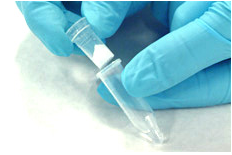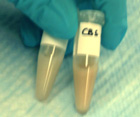Archival Notice
This is an archive page that is no longer being updated. It may contain outdated information and links may no longer function as originally intended.
Home | Glossary | Resources | Help | Contact Us | Course Map
Organic extraction techniques are used on all types of forensic samples. The basic organic extraction method is used on samples that do not contain spermatozoa, whereas a modified differential extraction is used on those samples containing spermatozoa.
Microcentrifuge tubes with spin baskets can be used for both basic and differential extractions, allowing the substrate (e.g. fabric, cotton swab, etc.) to be removed without difficulty during the extraction process.
This section outlines:
- Use of microcentrifuge tubes with spin baskets, which can be incorporated into most extraction methods
- Basic organic extraction
- Differential organic extraction
Microcentrifuge Tubes with Spin Baskets
Constructed with an open end and a woven end, spin baskets hold a cutting of substrate and are inserted into a common microcentrifuge tube. This allows for the retention of liquid carrying the biological material to be separated from the substrate during centrifugation steps. Any cells that may not be completely freed from the substrate are forced into the tube, along with the excess fluid. Spin baskets may be incorporated into most extraction methods; however, their composition prohibits immersion in phenol/chloroform/isoamyl alcohol (PCI).
Basic Organic Extraction
The basic organic extraction method can be used for most forensic samples, which includes bloodstains, saliva stains, tissue and hair. Details of the method are given in the laboratory manual.
A stain extraction buffer containing a buffer, detergent, DTT, and Proteinase K is added to the sample. This mixture is incubated, and the sample substrate is removed. Then, the mixture is extracted with a phenol/chloroform/isoamyl alcohol combination. The extracted DNA is generally purified and concentrated with a filtration device.07
Vortexed PCI
Aqueous Phase
Additional Online Courses
- What Every First Responding Officer Should Know About DNA Evidence
- Collecting DNA Evidence at Property Crime Scenes
- DNA – A Prosecutor’s Practice Notebook
- Crime Scene and DNA Basics
- Laboratory Safety Programs
- DNA Amplification
- Population Genetics and Statistics
- Non-STR DNA Markers: SNPs, Y-STRs, LCN and mtDNA
- Firearms Examiner Training
- Forensic DNA Education for Law Enforcement Decisionmakers
- What Every Investigator and Evidence Technician Should Know About DNA Evidence
- Principles of Forensic DNA for Officers of the Court
- Law 101: Legal Guide for the Forensic Expert
- Laboratory Orientation and Testing of Body Fluids and Tissues
- DNA Extraction and Quantitation
- STR Data Analysis and Interpretation
- Communication Skills, Report Writing, and Courtroom Testimony
- Español for Law Enforcement
- Amplified DNA Product Separation for Forensic Analysts




